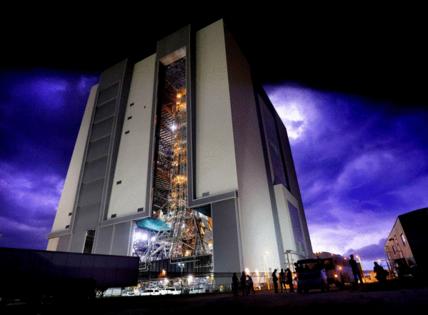NASA's Space Launch System rocket for moonbound Artemis II mission fully stacked at Kennedy Space Center
Published in News & Features
Despite the ongoing government shutdown, NASA did manage to complete a major milestone in its effort to send astronauts back to moon.
Teams completed the stacking of the Orion spacecraft atop the Space Launch System (SLS) rocket at Kennedy Space Center’s Vehicle Assembly Building this week.
The fully stacked rocket is slated to fly as early as Feb. 5 to take four astronauts on a trip around, but not land on, the moon on Orion’s first flight with humans on board.
NASA’s Exploration Ground Systems team lifted the Lockheed Martin-built spacecraft, which the astronauts have named Integrity, on Oct. 19 with a little more than three months to run through all the remaining required tests ahead of the earliest planned liftoff.
“Integration of SLS and Orion represents a major milestone in our progress on Artemis,” said acting NASA Administrator Sean Duffy. “Soon, we will be launching four astronauts around the moon for the first time in over half a century on Artemis II — the latest demonstration of American dominance in space.”
Duffy made TV news appearances Monday to tout the progress.
“They’re not going to land this time, but this is the first time in 54 years we’re going back to the moon,” he said on CNBC. “The original timeline was doing this launch in April. We think we can do it in in in early February, which is really cool.”
Now that the spacecraft has been mated with the rocket, teams will make electrical and data connections as well as umbilical connections from the mobile launcher on top of which the 322-foot-tall combined rocket stands.
“The full stack of Orion on the SLS is a truly spectacular sight,” said Robert Lightfoot, president of Lockheed Martin Space. “Our teams have been working tirelessly to finalize these last steps and ensure Orion takes the crew to the Moon and brings them home safely.”
The Artemis II crew of NASA commander Reid Wiseman, pilot Victor Glover, missions specialist Christina Koch and Canadian Space Agency astronaut and mission specialist Jeremy Hansen will do a countdown demo sitting in Orion while still parked in the Vehicle Assembly Building.
The mobile launcher will then be rolled to KSC’s Launch Pad 39-B for a full wet dress rehearsal during which teams will load propellant to the powerful rocket to ensure it’s ready for launch.
SLS remains the most powerful rocket to ever make it to orbit when it launched on the Artemis I mission in late 2022 on an uncrewed flight that orbited the moon. Its 8.8 million pounds of thrust on liftoff is powered by four RS-25 engines from L3Harris’s Aerojet Rocketdyne division that were modified from the Space Shuttle Program at the base of the Boeing-built core stage, coupled with two solid rocket boosters from Northrop Grumman.
The first SLS rocket flight performed extremely well, although the price tag for it along with timeline delays has been a source of criticism, to the point that Trump’s proposed 2026 NASA budget looked to eliminate use of SLS and Orion after Artemis III and rely instead of heavy-lift commercial rockets such as SpaceX’s Starship and Blue Origin’s New Glenn.
For now, though, a $10 billion insert led by Sen. Ted Cruz, R-Texas, into Trump’s Big, Beautiful Bill, has saved SLS and Orion through at least Artemis V, with future annual NASA budgets yet to be decided.
The Artemis II test mission is designed to pave the way for the moon landing mission of Artemis III, which was on NASA’s timeline to launch as early as summer 2027. Duffy admitted this week, though, that delays from SpaceX with its Starship program will push that to no earlier than 2028.
NASA had planned on using a version of Starship, which just had a successful 11th suborbital test flight from SpaceX’s Texas launch site, as that mission’s human landing system, with the goal of returning humans to the lunar surface for the first time since Apollo 17 in 1972.
Duffy, though, said NASA would reopen the Artemis III moon lander contract, which could mean competitor Blue Origin could swoop in the get the job done before President Trump leaves office, while also ensuring the U.S. beats China to the moon’s south pole in what politicians have been calling the second space race.
Blue Origin was already manufacturing its Mark 2 Blue Moon lander at its Merritt Island facilities for use on the Artemis V mission targeting 2023, and has an uncrewed, smaller Mark 1 lander ready to fly potentially before the end of the year for its first moon landing.
“Whatever one can get us there first to the moon, we’re going to take,” Duffy said.
_____
©2025 Orlando Sentinel. Visit orlandosentinel.com. Distributed by Tribune Content Agency, LLC.







Comments